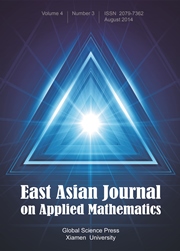Article contents
Sparse Grid Collocation Method for an Optimal Control Problem Involving a Stochastic Partial Differential Equation with Random Inputs
Published online by Cambridge University Press: 28 May 2015
Abstract
In this article, we propose and analyse a sparse grid collocation method to solve an optimal control problem involving an elliptic partial differential equation with random coefficients and forcing terms. The input data are assumed to be dependent on a finite number of random variables. We prove that an optimal solution exists, and derive an optimality system. A Galerkin approximation in physical space and a sparse grid collocation in the probability space is used. Error estimates for a fully discrete solution using an appropriate norm are provided, and we analyse the computational efficiency. Computational evidence complements the present theory, to show the effectiveness of our stochastic collocation method.
Keywords
Information
- Type
- Research Article
- Information
- Copyright
- Copyright © Global-Science Press 2014
References
- 2
- Cited by

